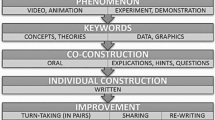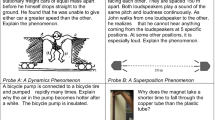Abstract
This study aims to characterize a group of students’ preliminary oral explanations of a scientific phenomenon produced as part of their learning process. The students were encouraged to use their own wordings to test out their own interpretation of observations when conducting practical activities. They presented their explanations orally in the whole class after having discussed and written down an explanation in a small group. The data consists of transcribed video recordings of the presented explanations, observation notes, and interviews. A genre perspective was used to characterize the students’ explanations together with analysis of the students use of scientific terms, gestures, and the language markers “sort of” and “like.” Based on the analysis we argue to separate between event-focused explanations, where the students describe how objects move, and object-focused explanations, where the students describe object properties and interactions. The first type uses observable events and few scientific terms, while the latter contains object properties and tentative use of scientific terms. Both types are accompanied by an extensive use of language markers and gestures. A third category, term-focused explanations, is used when the students only provide superficial explanations by expressing scientific terms. Here, the students’ use of language markers and gestures are low. The analyses shows how students’ explanations can be understood as tentative attempts to build on their current understanding and observations while trying to reach out for a deeper and scientific way of identifying observations and building explanations and new ways of talking.




Similar content being viewed by others
Notes
Keys is also referred to as Wallace, which was her name after 2002
References
Crowder, E. M. (1996). Gestures at work in sense-making science talk. Journal of the Learning Sciences, 5(3), 173–208.
Department for Education. (2013). National curriculum in England: science programmes of study. https://www.gov.uk/government/publications/national-curriculum-in-england-science-programmes-of-study/national-curriculum-in-england-science-programmes-of-study. Accessed 5 Sept 2014.
Driver, R., Leach, J., Millar, R., & Scott, P. (1996). Young people’s images of science. Maidenhead: Open University Press.
Hasund, I. K. (2003). The Discourse Markers" like" in English and" liksom" in Norwegian Teenage Language: A Corpus-based, Cross Linguistic Study(Doctoral dissertation, University of Bergen and Agder University College).
Kay, P. (1984). The kind of/sort of construction. Berkeley: Institute of Human Learning, University of California.
Keys, C. W. (1999). Revitalizing instruction in scientific genres: connecting knowledge production with writing to learn in science. Science Education, 83(2), 115–130.
Leach, J., & Scott, P. (2003). Individual and sociocultural views of learning in science education. Science & Education, 12(1), 91–113. doi:10.1023/a:1022665519862.
Lemke, J. L. (1990). Talking science: language, learning, and values. Norwood: Ablex.
Lijnse, P. (1995). “Developmental research” as a way to an empirically based “didactical structure” of science. Science Education, 79(2), 189–199.
Lunetta, V. N., Hofstein, A., & Clough, M. P. (2007). Learning and teaching in the school science laboratory: an analysis of research, theory and practice. In S. Abell & N. Lederman (Eds.), Handbook of research on science education (pp. 393–442). Mahwah: Lawrence Erlbaum.
Merriam, S. B. (1998). Qualitative research and case study applications in education. San Francisco: Jossey-Bass.
Mestad, I., & Kolstø, S. D. (2014). Using the concept of zone of proximal development to explore the Challenges of and opportunities in designing discourse activities based on practical work. Science Education, 98(6), 1054–1076.
National Research Council. (2012). A framework for K-12 science education: practices, crosscutting concepts, and core ideas. Washington, D.C.: The National Academies Press.
Ogborn, J., Kress, G., Martins, I., & McGillicuddy, K. (1996). Explaining science in the classroom. Buckingham, Philadelphia: Open University Press
Osborne, J. F., & Patterson, A. (2011). Scientific argument and explanation: a necessary distinction? Science Education, 95(4), 627–638. doi:10.1002/sce.20438.
Peker, D., & Wallace, C. (2011). Characterizing high school students’ written explanations in biology laboratories. Research in Science Education, 41(2), 169–191. doi:10.1007/s11165-009-9151-z.
Roth, W. M. (2000). From gesture to scientific language. Journal of Pragmatics, 32(11), 1683–1714. doi:10.1016/S0378-2166(99)00115-0.
Roth, W.-M., & Lawless, D. (2002). Science, culture, and the emergence of language. Science Education, 86(3), 368–385. doi:10.1002/sce.10008.
Roth, W. M., & Welzel, M. (2001). From activity to gestures and scientific language. Journal of Research in Science Teaching, 38(1), 103–136.
Strauss, A., & Corbin, J. M. (1990). Basics of qualitative research: grounded theory procedures and techniques. Newbury Park, CA: Sage Publications Inc.
Tiberghien, A. (2000). Designing teaching situations in the secondary school. In R. Millar, J. Leach, & J. Osborne (Eds.), Improving science education: the contribution of research (pp. 27–47). Buckingham: Open University Press.
Veel, R. (1997). Learning how to mean—scientifically speaking: apprenticeship into scientific discourse in the secondary school. In F. Christie & J. R. Martin (Eds.), Genre and institutions: social processes in the workplace and school (pp. 161–195). London: Cassel.
von Aufschnaiter, C., & Rogge, C. (2010). Misconceptions or missing conceptions? EURASIA Journal of Mathematics Science & Technology Education, 6(1), 3–18.
Vygotskij, L. S. (1978). Mind in society: the development of higher psychological processes. Cambridge: Harvard University Press.
Wallace, C. S. (2004). Framing new research in science literacy and language use: authenticity, multiple discourses, and the “third space”. Science Education, 88(6), 901–914. doi:10.1002/sce.20024.
Wittwer, J., & Renkl, A. (2008). Why instructional explanations often do not work: a framework for understanding the effectiveness of instructional explanations. Educational Psychologist, 43(1), 49–64.
Author information
Authors and Affiliations
Corresponding author
Rights and permissions
About this article
Cite this article
Mestad, I., Kolstø, S.D. Characterizing Students’ Attempts to Explain Observations from Practical Work: Intermediate Phases of Understanding. Res Sci Educ 47, 943–964 (2017). https://doi.org/10.1007/s11165-016-9534-x
Published:
Issue Date:
DOI: https://doi.org/10.1007/s11165-016-9534-x




